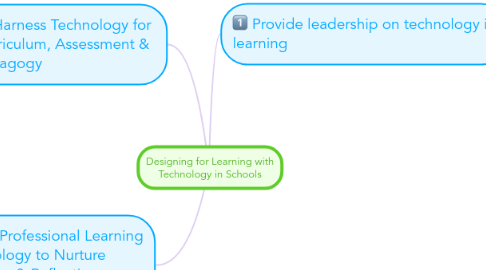
1. Harness Technology for Curriculum, Assessment & Pedagogy
1.1. Design for deep learning, acquisition of 21CC and formative assessment
1.1.1. What is the role of ICT in the active learning process to bring about subject disciplinary and 21CC outcomes?
1.1.1.1. Activate Learning
1.1.1.2. Promote Thinking & Discussion
1.1.1.3. Monitor and Provide Feedback
1.1.1.4. Facilitate Demonstration of Learning
2. Support Professional Learning with Technology to Nurture Collaborative & Reflective Practices
2.1. Identified knowledge and skills teachers need to have to design for active learning with technology (Refer to School Learning Log)
2.1.1. How do we tap on technology to design for differentiated professional learning and engender teachers’ ownership of learning?
2.1.2. How do we tap on technology to support teachers’ collaborative inquiry and professional discourse in learning teams?
2.1.3. How can technology be harnessed to capture the shifts in classroom practices and chronicle teachers' learning?
3. Provide leadership on technology in learning
3.1. Direction on ICT Use
3.1.1. What are the goals, subject and 21cc outcomes as defined in our school?
3.1.1.1. Using ICT actively with students by role modeling it to them.
3.1.1.2. Focus on the 21cc skills in the various subject content. Learning Outcome should shift to 21cc skills.
3.1.2. What is the role of the teacher?
3.1.2.1. Quality feedback to pupils.
3.1.2.2. More opportunity for pupils to learning how to take ownership for learning.
3.1.2.3. Learning reasoning skills and communication skills.
3.1.2.4. Learning experience of the pupils can be enhance using ICT.
3.1.2.5. Build the lesson plan - lesson design
3.1.3. What is the role of students?
3.1.3.1. Changing their mindset on PSLE focus to using ICT to learn for themselves.
3.1.3.2. Taking ownership of their own learning instead of depending on their teachers,
3.1.3.3. Learning on how to critique on their peers.
3.1.4. What is the role of technology in supporting the following interactions?
3.1.4.1. student-student
3.1.4.1.1. Learn from each other.
3.1.4.2. student-teacher
3.1.4.2.1. Using ICT to check for learning. Example: CL teachers using ICT for Oral practice and providing instant feedback.
3.1.4.3. student-content
3.1.4.3.1. Engaging the student and wanting them to share their learning with each other.
3.1.4.4. teacher-content
3.1.4.4.1. Lesson Design - Teacher needs to be skillful to use the technology.
3.1.4.4.2. Teacher needs to ensure that they have the subject mastery. Assessment of teacher's pedagogy needs to be access.
3.1.5. What is the role of technology to monitor and assess learning?
3.2. ICT-enriched Learning Environment
3.2.1. What are the digital resources and tools needed to meet varying needs of students and teachers?
3.2.1.1. Teachers
3.2.1.2. Students
3.2.2. How can we design learning spaces to support student-centric pedagogies?
